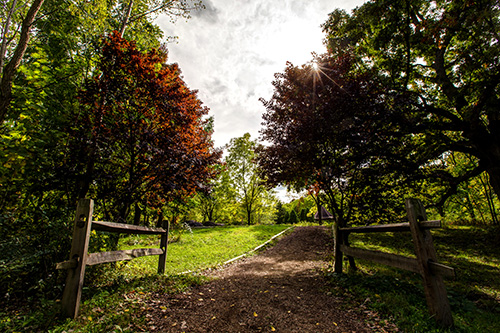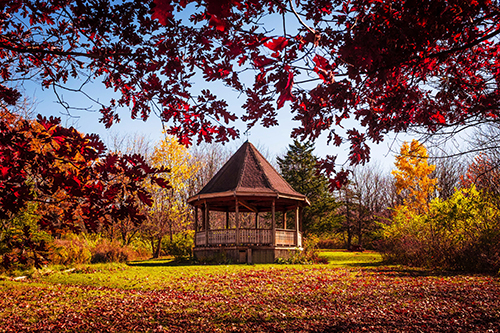
![]() Walk to the meadow on a clear summer night, and the skies above the Roemer Arboretum can reward your sleepy shuffle at 1 a.m. with bands of wavy white flowing across the Milky Way.
Walk to the meadow on a clear summer night, and the skies above the Roemer Arboretum can reward your sleepy shuffle at 1 a.m. with bands of wavy white flowing across the Milky Way.
On a morning stroll, if you look closely, there’s a civilization—and a war—playing out beneath your feet.
Rare slave-making ants with dozens of colonies in the campus preserve raid less-fortunate Formica glacialis, stealing and hauling their young back to their nest, where they spend their lives foraging for food for their captors, assuming they are their own kind.
Milkweeds planted to attract monarchs to Geneseo are nurseries for the larvae, whose sole food is this one type of plant. You can find the plants at the entrance and next to the gazebo for some weeks each summer.
“There are so many interesting things in there, if you look deeper,” says arboretum director and Associate Professor of Biology Jennifer Apple. “It’s a complete ecosystem — with life and death cycles and patterns and changes of these seemingly small things like bees and ants. The ecosystem reveals answers to how nature works, and provides us with more questions. “
For 25 years, the Roemer Arboretum has provided an oasis of green on the campus, where nature is both nurtured and runs its own course.
“In addition to being a really neat place to explore, the arboretum is our natural biology classroom,” says professor of biology Gregg Hartvigsen, who served as arboretum director from 1999 to 2013. “I continue to take my ecology students, rain or shine, heat or cold, to the arboretum.”
In this outdoor classroom, students have sought the answers to dozens of questions about the natural world of the arboretum: here, there are 70 species of shrubs, trees and plants, a complete ecosystem of plants and animals, some which we often overlook.
 Students and faculty monitor bird songs to study how human impacts on their habitat affect their behavior; they learn about the decomposition by micro-organisms, and discover what bees call SUNY Geneseo home, important now that world bee populations plummet.
Students and faculty monitor bird songs to study how human impacts on their habitat affect their behavior; they learn about the decomposition by micro-organisms, and discover what bees call SUNY Geneseo home, important now that world bee populations plummet.
There are also surprises. A specific species of spider moves its front legs to mimic movements of ant antennae to trick predators into thinking they are less tasty. Tiny treehopper insects suck plant juices from goldenrods and excrete a sugary waste product that ants use as food. The ants protect the treehoppers — which is their food source. The treehoppers even communicate threats to the ants through vibrations.
Student workers and volunteers maintain the grounds. And in 1990, the late Spencer J. Roemer, emeritus dean of admissions, created an endowment to make sure the land is never developed. In addition to having added a gazebo, they maintain trails, offer tours for the community, and to keep it pristine for another 25 years.
“Throughout the arboretum are large black walnut and red and white oak trees, remnants of a time more than 250 years ago when the Seneca lived in these lands,” says Hartvigsen. “These trees spread their broad branches, casting shade widely, and offer opportunities for visitors to reflect on the beauty and value of preserving areas like the arboretum for years to come.”
— By Kris Dreessen
— Photos by Keith Walters ’11
